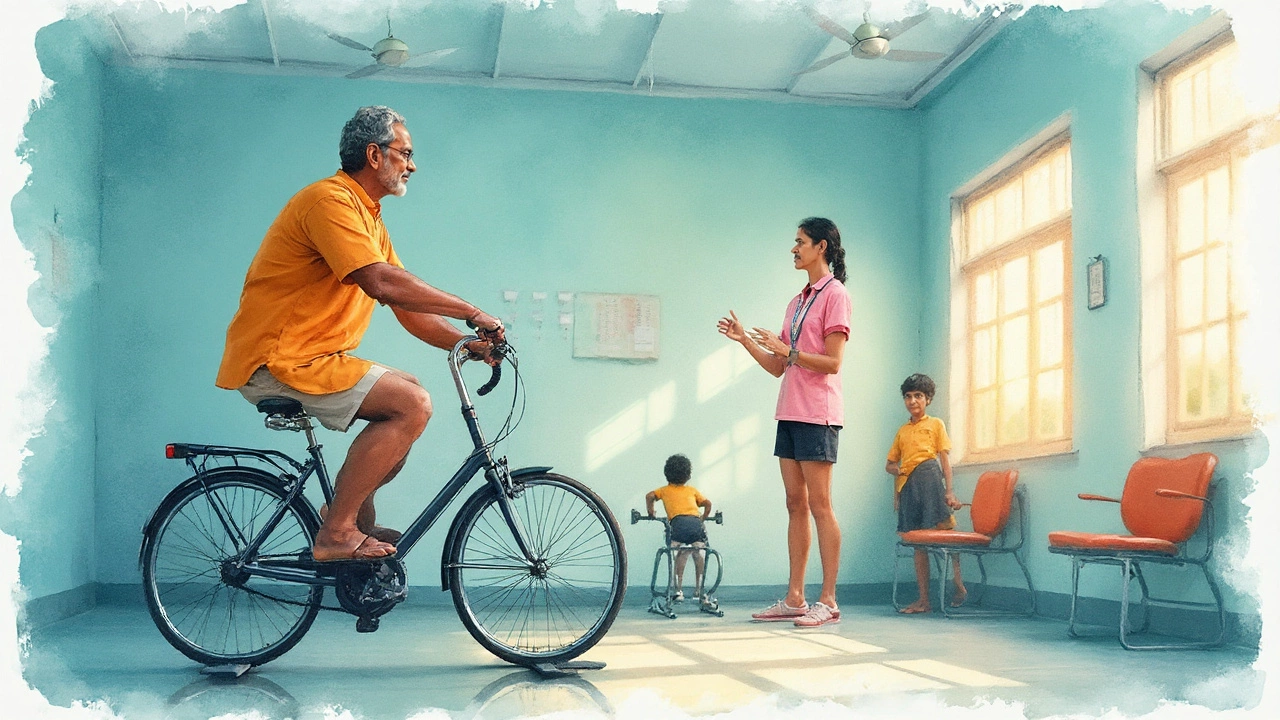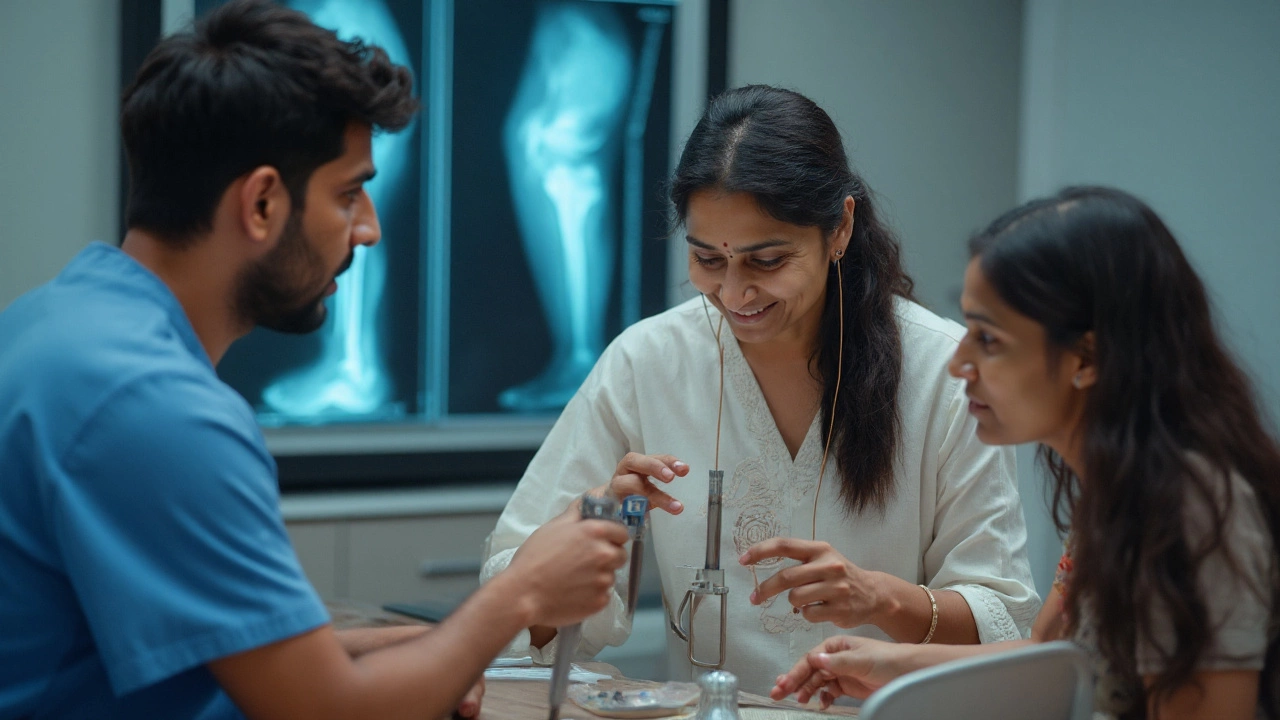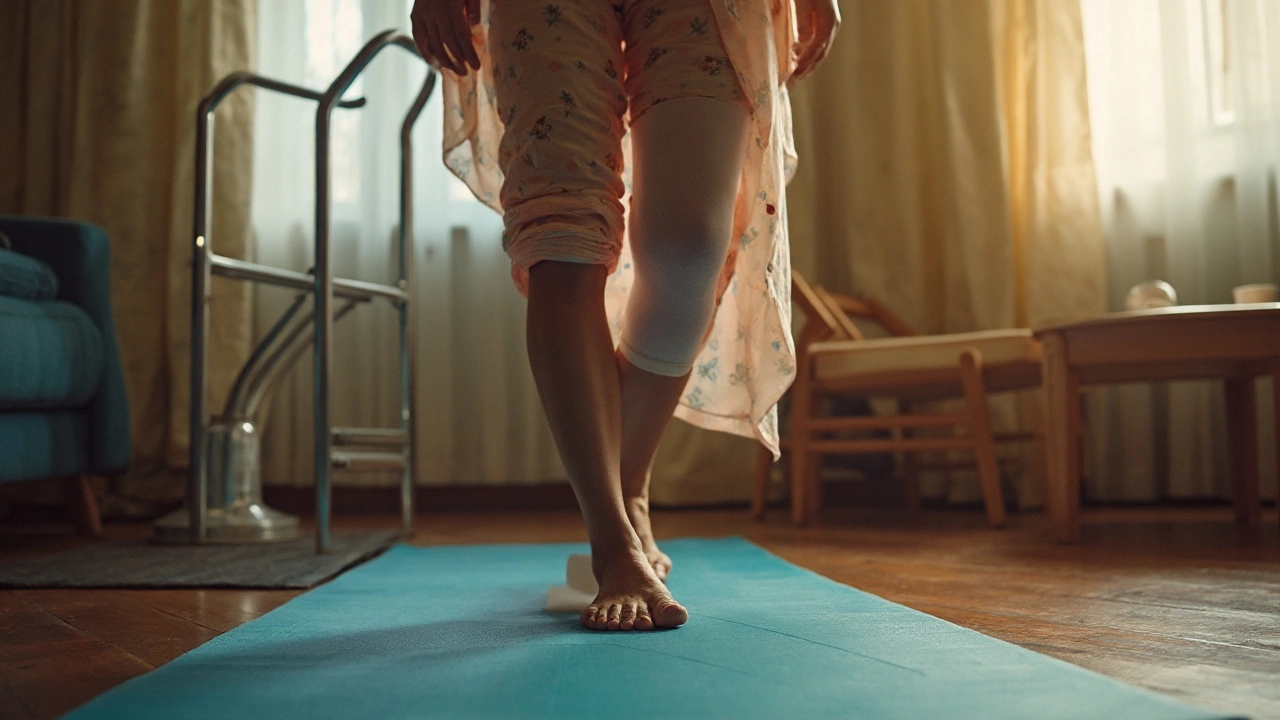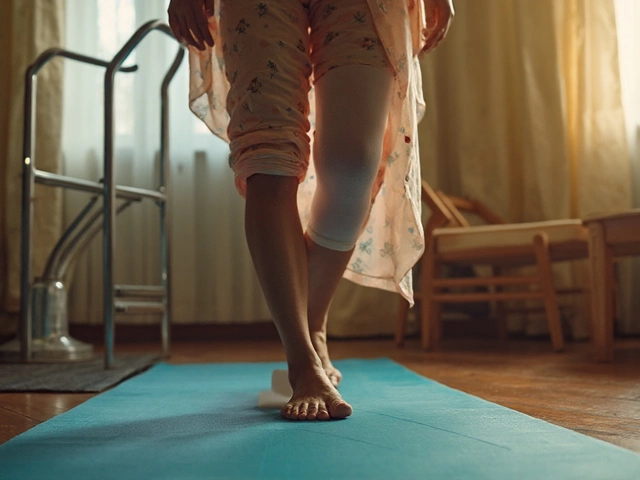Worried your new knee feels tight and stubborn? You’re not alone. Stiffness after total knee replacement is common, it usually improves, and there’s a clear window to get your best range of motion. The trick is knowing what’s normal, what isn’t, and what to do-right now-to stay on track.
TL;DR: Will stiffness go away after knee replacement?
- Yes, most people see stiffness ease steadily during the first 3-6 months, with gains up to 12 months. A small group (about 4-6%) needs extra help.
- Normal targets: full straightening (0° extension) by 6-8 weeks; at least 110-120° bending (flexion) by 3 months for daily life (stairs, tying shoes).
- If you’re under 90° flexion by 6 weeks-or you can’t straighten the knee by then-talk to your surgeon. Early action matters.
- The big culprits: swelling, pain-guarding, scar tissue (arthrofibrosis), poor pre-op motion, and sometimes implant factors or infection.
- Fixes range from better pain/swelling control and focused physiotherapy to manipulation under anesthesia (usually 6-12 weeks), and rarely arthroscopic release or revision.
Why stiffness happens and who’s at risk
Let’s set expectations. Your knee’s been through a major construction project. Early on, swelling acts like a tight water balloon, blocking motion. As pain eases and swelling comes down, the knee unlocks. The body then lays down scar tissue; if that scar stays flexible, you win. If it tightens and binds, you feel stiff. That’s the crossroads.
What’s “good enough” motion? For most daily tasks, you want 0° extension (the knee fully straight) and 110-120° flexion (a deep bend). That lets you sit comfortably, climb stairs, and get in/out of a car. Many people reach 90° by 2-3 weeks, 100-110° by 6-8 weeks, and keep improving to 6 months. Morning stiffness and a “band-like” tightness can linger up to a year, then fade.
Risk factors that make stiffness more likely:
- Limited pre-op motion (strongest predictor).
- Diabetes, smokers, high BMI, inflammatory arthritis.
- Previous knee surgeries or long-standing deformity.
- Poor early pain control and swelling that’s not managed.
- Less common but important: implant malposition/oversizing, patellar tracking issues, or low-grade infection.
What does the evidence say? The American Academy of Orthopaedic Surgeons (AAOS) notes most patients achieve functional ROM with steady rehab in the first 12 weeks. Studies in The Journal of Arthroplasty and JBJS report that 1-5% need manipulation under anesthesia (MUA) for stiffness, with better results if done within 12 weeks. A Cochrane review found continuous passive motion (CPM) machines don’t meaningfully improve long-term motion for most patients. NICE guidance emphasizes early, structured physiotherapy and red-flag monitoring.
Bottom line: stiffness is expected early; persistent, hard-end tightness after week 4-6 needs a plan. Don’t wait it out hoping it’ll magically disappear.

What to do in weeks 0-12: a simple plan that works
Here’s a no-nonsense routine I keep coming back to when friends and readers ask. It balances motion, strength, and swelling control-the trifecta.
Phase 1: Days 1-14 (Control swelling, win extension)
- Motion goals: 0-90° by the end of week 2. If you’re at 60-70° on day 3, you’re fine-keep at it.
- Ice and elevation: 15-20 minutes, 5-7 times a day. Elevate ankle above heart; don’t stack pillows under the knee for hours (causes a flexion contracture).
- Pain plan: schedule your pain meds for 7-10 days so you can move. Combine paracetamol (acetaminophen) and an NSAID if your doctor allows. Add icing before/after exercise. Adequate pain control is rehab fuel.
- Exercises (5-6 mini-sessions daily):
- Quad sets: 10 reps x 5 sets. Press the back of the knee down, hold 5 seconds.
- Heel slides: 10-15 reps x 3-4 sets. Use a towel to assist; stop at firm stretch, not sharp pain.
- Extension hangs: heel on a rolled towel, let the knee straighten by gravity, 2-5 minutes, 3 times a day.
- Ankle pumps: 20-30 reps, often, to reduce clot risk and swelling.
- Straight leg raises: 10 reps x 3 sets, once you can lift without a lag.
- Walking: little and often. Aim for 5-10 short walks a day at home. Use your walker/cane without guilt.
- Sleep setup: pillow under the ankle to encourage straightening; a cold pack before bed helps night pain.
Phase 2: Weeks 3-6 (Build flexion, normalize gait)
- Motion goals: 100-110° flexion by week 6; full extension 0°.
- Stationary bike: seat high. Start with half-revolutions backward. Once a full revolution happens, ride 10-15 minutes, 5-6 days/week, easy resistance.
- Strength & balance:
- Mini-squats to a chair: 2 sets of 10.
- Step-ups (10-15 cm step): 2 sets of 10 each leg.
- Terminal knee extensions with a band: 3 sets of 12.
- Single-leg standing (hold a counter): 3 x 20-30 seconds.
- Gait: aim to walk without a limp before ditching the cane. Shorter strides, heel-toe form.
- Heat before, ice after: warm pack for 10 minutes pre-exercise to soften the knee; ice for 15 minutes post.
- Stairs: “Up with the good, down with the bad” at first. Use rails. Practice controlled descents.
Phase 3: Weeks 7-12 (Strengthen, refine)
- Motion goals: 110-120° flexion by 12 weeks. Many gain more.
- Progression:
- Bike 20-30 minutes, light-moderate resistance.
- Leg press (light), hamstring curls, bridges: 2-3 sets of 10-12.
- Decline squats (small range) for patellar mechanics.
- Function: practice getting off the floor with support; car entries; kneeling briefly on a soft pad if your surgeon okays it.
- Walking: build to 30-45 minutes most days. If you prefer, water walking or pool exercises are kind on swelling.
Pro tips:
- Work on extension daily. A knee that doesn’t fully straighten makes walking and stairs tough.
- Measure progress weekly with a simple phone goniometer app or have your physio record it.
- Don’t chase pain. A firm stretch is right; sharp pain that lingers is a back-off signal.
- Breaks beat marathons: 10-15 minute focused sessions, many times a day, trump one long grind.
- CPM machines? Evidence says they don’t change long-term results for most patients. Use only if your surgeon has a specific reason.
Common pitfalls:
- Parking a pillow under the knee all day-invites permanent flexion tightness.
- Skipping pain meds, then skipping exercises because it hurts-spiral guaranteed.
- All flexion, no extension-half a win at best.
- Long, idle sitting-swells the knee and steals degrees. Set a movement timer every hour.
If you’re in India and physio access is uneven, ask your surgeon’s team for a written home program. Short, supervised check-ins (even via video) plus a disciplined home routine can match clinic-only results. Several RCTs have shown tele-rehab to be non-inferior to in-person therapy for knee replacement recovery.
When to worry and what doctors can do
Use these simple thresholds to decide if it’s time to call your surgeon or physio:
- By 2 weeks: flexion under 70° or you can’t reach the bed flat with the knee (extension lag) despite regular work.
- By 6 weeks: flexion under 90° or no progress for 2 straight weeks.
- By 12 weeks: flexion under 110° or extension lacking more than 5°.
- Anytime: a hot, very red knee with fever; sudden calf pain/swelling; chest pain/shortness of breath (emergency); wound drainage beyond a few days.
What your team might check:
- X-rays to confirm implant size and alignment.
- Blood tests (CRP/ESR) and possibly joint aspiration if infection is a concern.
- Gait and patellar tracking assessment; sometimes the kneecap mechanics are the limiter.
Interventions that actually help:
- Focused PT block: 2-3 weeks of intensified therapy with heat-before/ice-after and short-interval motion work can restart progress.
- Manipulation under anesthesia (MUA): the surgeon gently bends the knee while you’re under anesthesia to break scar bands. Best window: 6-12 weeks. Typical ROM gains: 20-40°. Risks are low but can include a small fracture or tendon strain. Studies in JBJS and The Journal of Arthroplasty show earlier MUA tends to yield bigger, more durable gains.
- Arthroscopic lysis of adhesions: keyhole surgery to cut tighter scar bands, often around 3-6 months if MUA isn’t enough or is done late.
- Revision or component adjustment: if imaging shows implant malposition, oversizing, or patellar problems, changing the mechanics can fix a “mechanical block” stiffness.
What about injections? Steroids inside a new knee replacement are used cautiously due to infection risk. Periarticular anesthetic-plus-NSAID injections early on are common and safe. Hyaluronic acid won’t help a replaced joint. Discuss with your surgeon before any injection.
Citations you can ask your doctor about: AAOS OrthoInfo guidance on TKA rehab (2024 update), NICE joint replacement recommendations, The Journal of Bone & Joint Surgery reports on timing of MUA (e.g., Issa et al.), and Cochrane reviews on CPM (2020 update). Your surgeon will know the local protocols that align with this research.

Quick tools: checklists, answers, and next steps
Daily checklist (first 6 weeks)
- Ice 5-7 times/day, 15-20 minutes with cloth barrier.
- Extension hangs: 2-5 minutes, 3x/day.
- Heel slides: 3-4 sets of 10-15 reps.
- Quad sets: 5 sets of 10 reps.
- Walk short bouts, 5-10 times/day.
- Bike (from week 3): 10-15 minutes, easy, most days.
- Pain meds on schedule if prescribed; stool softener if on opioids.
- Hydration, protein-rich meals (dal, eggs, curd, sprouts) to support healing.
Red flags you shouldn’t ignore
- Fever above 38°C with a hot, red, very painful knee.
- Sudden calf pain, one leg swelling much more than the other.
- Shortness of breath or chest pain (emergency care needed).
- Wound drainage beyond day 5-7, or foul smell.
Mini-FAQ
- How long does stiffness last? Most easing happens by 3-6 months. Mild morning tightness can linger to 12 months. A small number have long-term stiffness without early intervention.
- Is my knee supposed to feel tight like a band? Yes, a “band-like” anterior tightness is common for a few months. It fades as swelling and soft tissues settle.
- Do I need a CPM machine? Usually no. Cochrane reviews show little long-term benefit for most people.
- When can I drive? Often 4-6 weeks for the left knee with an automatic, 6-8 weeks for the right knee-once you’re off strong pain meds and can brake hard safely. Confirm with your surgeon and insurer.
- Climbing stairs? It’s fine to practice with support as pain allows. Controlled descents are harder; use a rail and go slow.
- Kneeling after a knee replacement? Safe for many by 3-6 months, though it can feel odd or numb. Use a soft pad. Some people never love the sensation, and that’s okay.
- Will weather or air conditioning worsen stiffness? Temp changes can make the knee feel tighter but don’t harm it. Warm up before activity.
- Supplements for stiffness? No supplement has proven to break scar tissue. Omega-3s and adequate vitamin D support general recovery. Check interactions if you’re on blood thinners.
- Can yoga help? Gentle, modified poses that respect range limits can help mobility and balance. Avoid deep loaded flexion early on.
- I hear clicks in my knee. Normal? Often yes. Artificial joints can click as they move. Painful grinding is not normal-report it.
Decision guide (what to do based on your ROM)
- Week 2: < 70° flexion or can’t straighten? Alert your physio. Increase frequency of short sessions; adjust pain control.
- Week 4: Stalled progress for 2 weeks? Add heat-before/ice-after, consider supervised therapy, reassess swelling and gait.
- Week 6: < 90° flexion or > 5° extension lag? Book a surgeon review. Discuss timing for possible MUA.
- Week 8-12: Still < 110°? MUA may still help; earlier tends to be better. If MUA fails or is late, discuss arthroscopic release.
- After 6 months: Consider mechanical causes or low-grade infection; imaging and labs guide next steps, sometimes revision.
Troubleshooting by scenario
- I’m diabetic and swelling won’t quit. Keep sugars tightly controlled (poor glucose slows healing). Short, frequent walks; don’t sit long. Use compression stockings if cleared. Add an extra icing block midday.
- I’m stuck at 90° at 7 weeks. You’re right at the decision point. Book your surgeon. A 2-3 week intensive PT block plus timely MUA can add 20-40°.
- I had an MUA and gained 20°-how do I keep it? Strike while the iron’s hot: daily bike, 4-6 motion sessions/day, ice after every session for a week, then taper. Don’t skip a day in the first two weeks.
- It’s been a year, and I’m still tight. Some morning stiffness is common. If function is limited (can’t kneel, can’t descend stairs), ask for a review: patellar mechanics, component sizing, and scar bands can be addressed even late.
- No easy access to physio where I live. Follow the home plan above, plus a weekly video check-in. Use a stationary cycle (or a low step for knee bends). Progress is about consistency, not fancy machines.
- I need to kneel for prayer or chores. Start with a thick foam pad at 10-12 weeks. Ease in for 20-30 seconds at a time. Sensation improves as numbness decreases.
Do vs Don’t (quick glance)
- Do: short frequent motion work, ice a lot, heat before exercises, track ROM weekly, call early if you’re stuck.
- Don’t: park a pillow under the knee all day, sit for hours, grind through sharp pain, wait months hoping stiffness will vanish by itself.
If you remember only one thing, remember this: early, consistent motion paired with solid swelling and pain control decides how much knee replacement stiffness you carry into month three. If you’re falling behind at week six, speak up-there are proven options to get you back on track.






